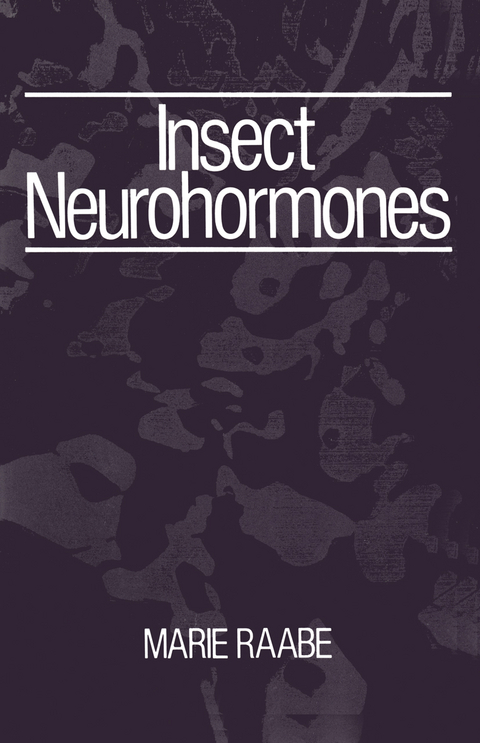
Insect Neurohormones
Springer-Verlag New York Inc.
978-1-4684-4015-7 (ISBN)
1 Synthesis, Storage, and Release of Neurohormones.- 1.1. The Neurosecretory Cells.- 1.2. Neurohormone Release Sites.- 1.3. Neurohormones and Biogenic Amines.- 1.4. Conclusions.- 2 Control of Endocrine Gland Activity.- 2.1. Molting Gland.- 2.2. Corpora Cardiaca.- 2.3. Corpora Allata.- 3 Diapause.- 3.1. Imaginal Diapause.- 3.2. Pupal Diapause.- 3.3. Larval Diapause.- 3.4. Embryonic Diapause.- 3.5. Conclusions.- 4 Reproduction.- 4.1. Sex Determination.- 4.2. Gonial Mitosis and Meiosis.- 4.3. Differentiation of the Ovariole—Previtellogenesis.- 4.4. Vitellogenesis.- 4.5. Oostatic Hormone (Antigonadotropin).- 4.6. Spermatogenesis.- 4.7. Accessory Glands, Pheromone Production, Sexual Behavior.- 4.8. Ovulation.- 4.9, Egg Laying.- 4.10. Conclusions.- 5 Functioning of the Visceral Muscles.- 5.1. The Visceral Muscles: Innervation and Functioning.- 5.2. Source of Myotropic Factors, Multiplicity.- 5.3. Release Sites of Myotropic Factors.- 5.4. Reality of the Existence of Myotropic Factors.- 5.5. Separation and Identification of Active Factors.- 5.6. Mode of Action of Myotropic Factors.- 5.7. Conclusions.- 6 Morphological and Physiological Color Change.- 6.1. Morphological Color Change.- 6.2. Physiological Color Change.- 6.3. Conclusions.- 7 Behavior and Rhythmic Phenomena.- 7.1. Flight.- 7.2. Circadian Rhythms and Activity Level.- 7.3. Eclosion Rhythm.- 7.4. Endogenous Nerve Activity.- 7.5. Egg Care.- 7.6. Polymorphism and Phase.- 7.7. Conclusions.- 8 Osmoregulation.- 8.1. Techniques.- 8.2. Diuretic Hormone.- 8.3. Antidiuretic Hormone.- 8.4. Diuretic or Antidiuretic Function of Other Hormones.- 8.5. Purification of Diuretic and Antidiuretic Hormones.- 8.6. Mode of Action of Diuretic Hormone.- 8.7. Ion Metabolism.- 8.8. Conclusions.- 9 Metabolism.- 9.1. Proteases and Amylases.-9.2. Proteins.- 9.3. Carbohydrates.- 9.4. Lipids.- 9.5. Respiratory Metabolism.- 9.6. Purification of Metabolic Neurohormones.- 9.7. Metabolic Hormones of Vertebrates and Insects.- 9.8. Mode of Action of Metabolic Hormones.- 9.9. Conclusions.- 10 Neurohormones and Cuticle.- 10.1. Tanning.- 10.2. Plasticization.- 10.3. Melanization.- 10.4. Endocuticle Secretion.- 10.5. Disaggregation of Cell Fragments of the Wings.- 10.6. Diuresis Linked to Tanning.- 10.7. Puparium Formation.- 10.8. Interspecific Activity.- 10.9. Neurohormone Purification.- 10.10. Mode of Action of Tanning Hormones.- 10.11. Conclusions.- Concluding Remarks.- Addendum.- A.1. Synthesis, Storage, and Release of Neurohormones.- A.1.1. Neurophysin and Neurohormones.- A.1.2. Immunoreactive Compounds.- A.1.3. Brain Neurosecretory Cells.- A.1.4. Neurosecretory Cells of the Sympathetic Nervous System.- A.1.5. Peripheral Neurosecretory Cells.- A.1.6. Release Sites of Brain Neurosecretory Products.- A.2. Control of Endocrine Gland Activity.- A.2.1. Control of Brain Hormone Secretion.- A.2.2. Molting Gland Activation.- A.2.3. Molting Gland-Innervating Neurons.- A.2.4. Juvenile Hormone and Molting Gland Stimulation.- A.2.5. Brain Hormone Purification.- A.2.6. Ecdysone Production in the Ovary.- A.2.7. Ecdysone and Corpora Allata Activity.- A.2.8. Juvenile Hormone Esterase Regulation.- A.3. Diapause.- A.3.1. Pupal Diapause Regulation.- A.3.2. Embryonic Diapause.- A.4. Reproduction.- A.4.1. Vitellogenesis.- A.4.2. Ecdysone and Brain Neurosecretory Activity.- A.4.3. Origin of Antigonadotropins.- A.5. Functioning of the Visceral Muscles.- A.5.1. Proctolin Source Cells.- A.5.2. Myotropic Factors.- A.6. Morphological and Physiological Color Change.- A.6.1. Insect and Crustacean Chromactivating Factors.- A.7. Behavior and Rhythmic Phenomena.- A.7.1. Eclosion Hormone.- A.8. Osmoregulation.- A.8.1. Diuretic Hormone.- A.8.2. Origin of Diuretic Hormone.- A.8.3. Ion Regulation.- A.8.4. Mode of Action of Diuretic Hormone.- A.9. Metabolism.- A.9.1. Protease and Amylase Regulation.- A.9.2. Adipokinetic Hormone Interspecific Activity.- A.9.3. Hypertrehalosemic and Adipokinetic Hormones.- A.9.4. Insulinlike and Glucagonlike Substances in Insects.- A.10. Neurohormones and Cuticle.- A.10.1. A New Factor Involved in Pupariation.- Reviews and Monographs.- References.- Species Index.
| Zusatzinfo | XVI, 352 p. |
|---|---|
| Verlagsort | New York, NY |
| Sprache | englisch |
| Maße | 152 x 229 mm |
| Themenwelt | Naturwissenschaften ► Biologie ► Evolution |
| Naturwissenschaften ► Biologie ► Zoologie | |
| ISBN-10 | 1-4684-4015-2 / 1468440152 |
| ISBN-13 | 978-1-4684-4015-7 / 9781468440157 |
| Zustand | Neuware |
| Haben Sie eine Frage zum Produkt? |
aus dem Bereich


